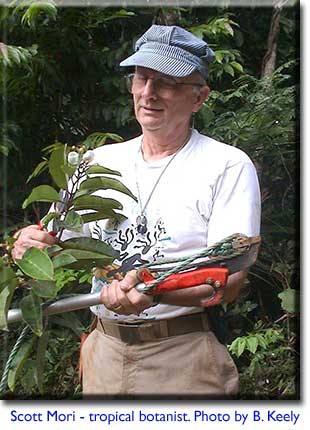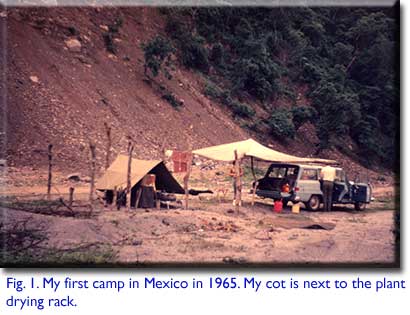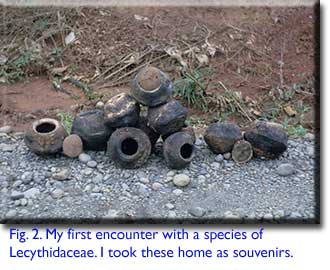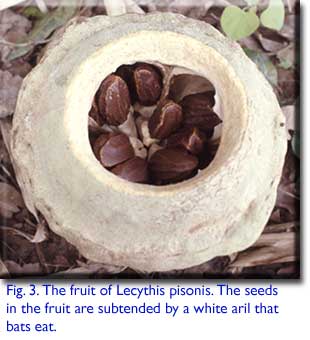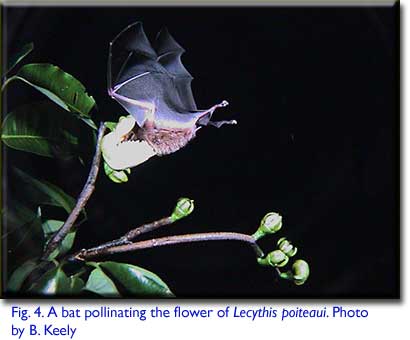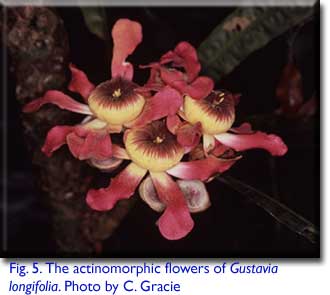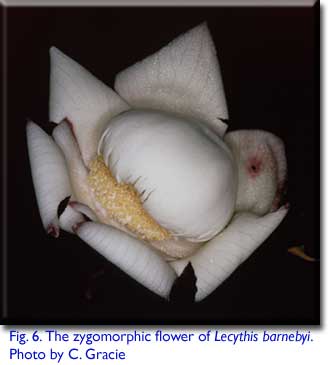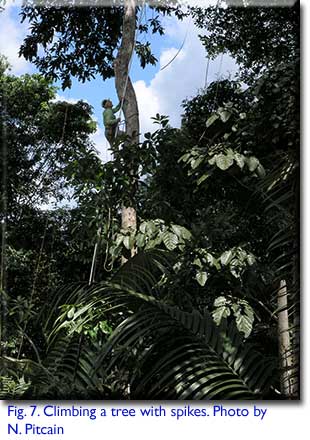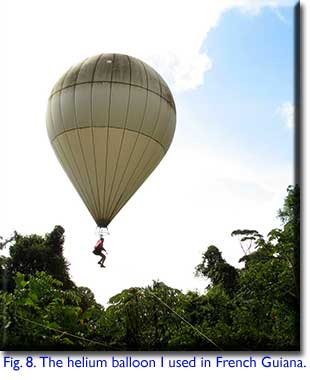How I became a Tropical BotanistCareers In BotanyScott A. Mori, Nathaniel Lord Britton Curator of Botany, The New York Botanical Garden, Bronx, New York 10458-5126
By the time I reached high school I had developed an interest in natural history because of my experiences camping with the Boy Scouts and hunting for rabbits and pheasants with my father, an uncle, and a neighbor. I lived in a small town of 1500 people in farming country in southeastern Wisconsin where there were hunting preserves, woodlands, lakes, and marshes scattered among the corn fields. Especially important to me was a wildlife refuge called Storr’s Lake which put nature within a mile of my back door. Before I had my driver’s license, I would hoist my canoe and portage it to the lake where I hunted and ran a trap line to catch muskrats and an occasional mink. Spending so much time at Storr’s Lake also turned me into a bird watcher and stimulated my interest to learn about the plants that animals depend upon for food and shelter. This was the start of my interest in plants and plant/animal interactions which I continue today in my studies of pollination and dispersal of species of the Brazil nut family. I also developed an interest in conservation and was influenced by our local game warden, Royce Dallman, and my experience as President of the Conservation Club at Milton Union High School. After graduation, I packed my bags and traveled to the University of Wisconsin at Stevens Point to pursue an undergraduate degree in Biology and Conservation. Although I was a somewhat above average student in high school, I was concerned with not doing well because I had never studied very much. Because of this fear, I studied a great deal my first weeks at the University and the results of my first test, by coincidence in Botany, ranked me at the top of the class. The study habits I developed in those first months carried over for all of my classes at Stevens Point, and I finished with a high grade point average. Because of my grades and keen interest in Biology, one of my teachers, Dr. Simpson, encouraged me to go on graduate school to earn an advanced degree. Inspired by his encouragement, I applied to the University of Wisconsin at Madison (UW) to work for an M.S. in Biology. My goal was to become a high school biology teacher and a coach of football and wrestling. I had participated in football, basketball, and wrestling in high school and ran track and wrestled at Stevens Point. Being athletic has contributed to my career success by enhancing my ability to reach undiscovered plants in the tree tops.
I went to Madison without a fellowship, so I worked very hard that summer to earn money to pay for my tuition and lodging during the upcoming school year. The fact that I paid most of my own way gave me an even greater motivation to study hard and get the most for my money. I never looked at my courses as solely valuable for the grades I would get, but instead viewed them as an opportunity to learn as much about a topic as I could. That first semester, I enrolled in Phytogeography, which was taught by Botanist Dr. Hugh Iltis, and the direction of my career aspirations took a different course. Iltis, a fiery teacher and avid conservationist, liked the work ethic and attitude that I displayed on a field-trip to the Smokey Mountains and offered me an opportunity to be a research assistant for his Ph.D. student Keith Roe on an expedition to Mexico in the summer of 1966. The purpose of the trip was to collect species of Solanum for Keith’s research and to make general collections for the University of Wisconsin Herbarium (Fig. 1). I also applied for support from the Department of Botany for the next year and was awarded a Teaching Assistantship thereby making it possible for me to participate in my first adventure to Latin America.
As I look back on that trip, I now realize that collecting plants fulfilled two of my interests: a chance to incorporate vigorous, outdoor work as part of my career as well as the opportunity to learn about natural history. I can even pinpoint the place and time that I decided to become a botanist; it was along a swiftly flowing stream through undisturbed forest in Tabasco where Keith had assigned me to collect while he and his wife Eunice explored elsewhere for species of Solanum. Everywhere I looked there was a different plant and as I collected them — often watching hummingbirds visiting the red-flowered ones — I marveled at the amazing diversity of flower types. Because of that glorious day, I resolved to change my research project from looking at the systematics of the temperate genus Gnaphalium to some, as yet unknown, tropical plant. Iltis was overjoyed with our collections. Not only had we gathered many specimens of Solanum but we had “hay-bailed” enough general collections to enrich the University’s herbarium and, more importantly, satisfy him. The tropics were now in my blood, and the following year Roger Anderson, another Ph. D. student in Botany at Madison, and I traveled to Costa Rica to take a course in tropical grasses taught by Richard W. Pohl. Anderson and I left Madison several weeks early to research tropical plants, even though we did not yet know which ones. Our wanderings took us to the sleepy village of Puerto Viejo and on our exploratory walks we observed swamps dominated by the palm Raphia taedigera. Amazed by these dense aggregations of palms with huge leaves, we decided to describe the habitat using the ecological methods of Curtis and Cottam that we had learned at UW; little did we realize that tropical swamps are among the worst habitats in the world to make ecological measurements. At the end of a day wading in water, being stung by insects, and reaching around palm bases to measure their diameters we were mental and physical wrecks and so ugly that we scared ourselves when we took off our sodden shoes or looked in the mirror. But we persisted and our results were published in the journal Turrialba in 1967 — this was my first scientific publication and I was delighted to see my name in press as the second author.
Today the area around Puerto Viejo is dedicated to cattle and farming, but there still remains enough forest to attract eco-tourists. In addition, one of the most famous tropical research sites, La Selva operated by the Organization for Tropical Studies (OTS), is found a short distance from the village. At the time we visited, the OTS site was still the finca (farm) of Dr. Leslie Holdridge, a famous plant ecologist who developed the life-zone system of vegetation classification. By chance Roger and I met Dr. Holdridge unloading bananas from a boat on the Río Sarapiqui onto his truck to be taken to market in San José. When we learned that Holdridge was a botanist, we excitedly showed him one of our collections, a plant with unusual flowers coming from the trunk of the tree, and asked him what it was. We were mortified when he told us that it was Theobroma cacao (cocoa), one of the most commonly cultivated trees in the New World tropics! When Roger and I returned from Costa Rica, Dr. Iltis showed me a list of plants that John Wurdack of the Smithsonian Institution said were in need on taxonomic revision. On that list was a group of trees belonging to the Brazil nut family (Lecythidaceae). I knew that the monkey pots I had collected one day returning from the Raphia swamp (Fig.2) belonged to that family and immediately decided to study its taxonomy and ecology for my M.S. degree, and, as it turned out later, for my Ph.D. THE BRAZIL NUT FAMILY
My studies of the Brazil nut family have enabled me to work with plants that have large, showy, and complex flowers and mostly woody fruits that open by a circular lid to expose the seeds to dispersal agents (Fig. 3). The flowers are pollinated predominantly by bees, but those of three species are visited by bats (Fig.4). The Brazil nut family is found in tropical forests of Central and South America, Africa, and southeast Asia but the Old World species are very different from the New World species because only in the New World have radially symmetrical (actinomorphic) (Fig.5) flowers led to the evolution of bilaterally symmetrical (zygomorphic) ones (Fig.6.). In the Neotropics floral zygomorphy promoted the evolution of species adapted for pollination in different ways; i.e. flower structure, aroma, and pollen types vary. For example, pollinators of New World species with actinomorphic flowers are attracted by non-differentiated pollen as a reward (i.e., the pollen collected is the same as that which fertilizes the ovules), whereas in some zygomorphic-flowered species the pollinator is rewarded by pollen that does not germinate (pollen that germinates is found in a different part of the flower), and in others, the zygomorphic flowers offer nectar to lure pollinators. Likewise, the dispersal of seeds is accomplished by a number of different dispersal agents; many species are dispersed by bats, others by peccaries and pacas, the species of two genera by wind, and relatively few species by water. More detailed information can be found on the “The Lecythidaceae Pages” which can be accessed from my home page (https://www.nybg.org/person/scott-mori/).
I, as most botanists who study plants, am in love with the plants that I study. The work of systematists includes tedious jobs such as sectioning flowers, keeping track of specimens in databases, counting chromosomes, sequencing genes, etc. so an appreciation of the group under study and a deep curiosity about the classification, ecology, and evolution of “your family” will provide the incentive to get through the difficult jobs of plant systematics. Although I work on plants with beautiful flowers and interesting fruits, almost all tropical plants, regardless of their size or beauty, have exciting secrets waiting to be revealed by careful research. WHAT IS A CURATOR? Upon completing my Ph. D. in 1974, I took a job with the Missouri Botanical Garden to be their plant collector in Panama. Based in Panama for a year, I took several trips each month to explore all vegetation types in the most remote corners of the country. My collections were distributed to botanical specialists throughout the world, and a number of them visited me to collect and study plants. For example, Paul Maas came to collect specimens for his study of the gingers (Costaceae and Zingiberaceae) which enhanced his monographs published in Flora Neotropica, a journal dedicated to providing information on the classification, morphology, anatomy, molecular sequences, common names, distribution, uses, and evolution of plants of the Neotropics. The distribution of duplicates of specimens to specialists made my work known to all those studying New World tropical plants and convinced G. T. Prance of The New York Botanical Garden (NYBG) to invite me to work with him as a post-doc for three years studying the Brazil nut family. After that experience, I accepted a job with the Cocoa Research Center in Bahia, Brazil to conduct botanical exploration and manage their herbarium as I had done in Panama. After three years of exciting botanical discovery, Prance invited me back to NYBG to continue our collaboration on the Brazil nut family as an Assistant Curator. He also encouraged me to become a specialist in the Flora of the Guianas which has resulted in the publication of the Guide to the Vascular Plants of Central French Guiana (1997, 2002).
The job of a curator is to care for the collections in a museum such as the Herbarium of NYBG. In small herbaria, the curator is responsible for the entire collection, in others the curator handles a group of related families, and in others the curator identifies and curates only the family of his or her specialty. For example, at NYBG Michael Nee curates the families Cucurbitaceae and Solanaceae. Jim Luteyn the Ericaceae, Andrew Henderson the palms, John Mickel and Robbin Moran the ferns, Bill Buck the mosses, Roy Halling the fungi, etc. Information about the curators of the Institute of Systematic Botany can be seen by going to my home page (https://www.nybg.org/plant-research-and-conservation/tour/systematic-botany/) and clicking on “Botanical Art.” For further information about them you can visit their individual web pages at NYG. The main responsibility of a curator is to make certain that the specimens have collection labels and are mounted on herbarium sheets, identified, entered into the herbarium’s database, and properly organized in the herbarium. In addition, curators organize research expeditions; raise money for research and institutional overhead; publish research on the groups of plants they study; interact with the public by giving lectures or leading eco-tours; respond to calls on poison plants or mushrooms, etc.; teach at universities and in adult education programs; and provide professional services such a serving as officers in botanical organizations, identifying plant collections, training students, collaborating with other botanists and organizations, editing manuscripts for journals, etc. Why is the work of a curator important? The fundamental importance of plant systematics is that it establishes the basis for all plant research by providing names for the plants under study. Many studies, such as those of counting chromosomes and producing molecular sequences require the collection, identification, and archiving of specimens of the plant in a herbarium to serve as a voucher for the information presented. If there is doubt about the identity of the plant, the voucher specimen can be located and the determination checked. Once the name of a plant is known, all knowledge associated with the plant becomes available to those who wish to use it. Information may be retrieved for a wide range of purposes, e.g., deciding if a plant is an endangered species or not; determining if a species is poisonous or has medicinal value; planning the location of biological reserves in places that will result in the conservation of the greatest number of species; writing popular books about plants to increase the knowledge and enjoyment of the natural world for non-botanists; developing new food, fiber, and fuel resources; improving the productivity of economically important plants by breeding them with their nearest relatives; identifying plants for study of potential economic uses; and providing the framework against which phylogenetic studies can be interpreted. Systematists not only makes it possible for others to find and determine the names of plants, but it also gathers much of the basic information attached to the names of plants. One of the important responsibilities of botanical gardens, universities, and museums that possess herbaria is to safeguard their vast collection of biodiversity information. This requires a great deal of money, much of which must be raised from donors who believe in the importance of the search for new and useful information about plants or who are concerned about the conservation of plants. It is difficult to justify the importance of herbaria and taxonomic research by only considering single projects because it is the sum of all the societal benefits generated from the study of systematic botany and associated fields of study that is important. I will provide three examples of the benefits of systematic botany. The first example is the Gleason and Cronquist Manual of Vascular Plants of Northeastern United States and Adjacent Canada and The Illustrated Companion to Gleason and Cronquist Manual edited by Noel Holmgren; both are based on collections archived in herbaria. These two books provide the basic knowledge needed to write and publish wildflower guides used by lay people in their quest for learning about and appreciating the environment in which they live. The value of printed field guides is priceless in terms of the pleasure that they provide to the users and, thus, like the music of great composers or any other artistic endeavor, cannot be properly appraised in monetary terms. The effort to justify herbaria and systematic botany as a discipline loses much of its impact because the value of improving the intellectual lives of humans cannot be calculated in dollars. At the same time, there are many examples of taxonomic studies that do have direct economic impact. Thus, my second example is the discovery by Hugh Iltis and Don Ugent in 1962 in Peru of a small-fruited tomato which they collected, gathered seeds of, and subsequently deposited specimens of in the herbarium of the University of Wisconsin as well as other important herbaria. They had traveled to Peru to study potatoes but they collected all plants, especially other members of the potato family. The seeds were sent to Dr. Charles Rick, a tomato geneticist at the time located at the University of California, Davis. Rick reported that this tomato, named as a new species (Lycopersicon chmielewskii) by him, led to the production of several new tomato strains with larger fruit. Most importantly, the new strains had higher soluble solids, mainly fructose, glucose, and other sugars, that increased the soluble solids from the normal 4.5 -6.2% to 7-7.5%. Rick reported to Iltis and Ugent that a 0.5% sugar content increase was worth about a million dollars a year. At 1987 prices, the new strains of tomato created by Rick were worth about 8 million dollars a year (Iltis, 1988). This represents a very high return on the investment of $21,000 that the National Science Foundation provided for the three-year study of Ugent and Iltis on potatoes. This scenario could be repeated, for example for sunflowers or other economically important plants, and these kinds of contributions more than justify society’s investment in systematic botany. My last example deals with conservation; the protection of endangered species of plants would not be possible without the floras and monographs produced by plant systematists. For the last thirty years, I have been a colleague of two very hard-working systematists, Noel and Pat Holmgren, who have been major contributors to the Intermountain Flora and now direct the completion of the final volumes. This book has been praised for many reasons, but high on the list is its contribution to plant conservation. As a testimony to the importance of this flora, Teresa Prendusi (Regional Botanist, U.S. Forest Service, Intermountain Region, Ogden, Utah) wrote to the Holmgrens as follows: "Intermountain Flora has been an indispensable tool for us as well as for other Federal (BLM, FWS, NPS, NRCS, DOE) and State agencies for the Interior West. Every natural resource specialist in the fields of Botany, Ecology, Range Management, Soil Science, and Forestry utilizes this reference on a regular, if not daily basis..." CHANGES IN SYSTEMATIC BOTANY
Over my 41 years as a tropical botanist I have witnessed many changes. One constant, however, is that the original source of information about plants comes from studying and collecting them in the field. Subsequent laboratory studies of herbarium specimens, pickled collections, images, and DNA samples augment this knowledge. The most significant changes are 1) awareness that tropical vegetation and the species composing it are threatened with destruction and extinction, 2) ability to explore the canopy, 3) use of computers in processing collections and analyzing data, 4) wide acceptance of cladistics to interpret evolution, 4) discovery that molecular data can be used to determine evolutionary relationships of plants, and 5) difficulty in obtaining permission to do field work in other countries. Several years after I started pursuing my graduate degrees two publications appeared: Paul Ehrlich’s The Population Bomb about the need to control human population and Arturo Gomez-Pompa et al.’s article entitled The tropical rain forest: a non-renewable resource. Up until then many collectors felled trees in order to make collections from the trees’ crowns. Because 68% of tropical plant diversity is represented by trees and plants such as epiphytes and lianas that are found in the canopy, this strata of the forest is particularly rich in species. The desire to explore the canopy of tropical forests without destroying habitat led to a new era of canopy exploration. I and other plant explorers realized that the only non-destructive way to collect tropical trees was to climb into the tree tops; this has led to canopy exploration using diverse techniques such as climbing ropes, spikes, canopy walkways, cranes, and dirigibles. Although I usually climb with spikes (Fig. 7), I was thrilled to skim along the top of the canopy collecting plants in primary forest on my last expedition to French Guiana while dangling from a helium-filled balloon (Fig. 8). Computers have made the production of herbarium labels and the organization of collections more efficient. When I first started making collections, labels were individually typed using a mechanical typewriter. Today, when I return from the field, data from my field book is entered into the database of The New York Botanical Garden’s Virtual Herbarium. This database can generate a checklist of any geographic area of interest for which we have collections and enables the user to consultall of the collection information as well as studyassociated digital images. Because of computers, processes that took years to complete when I started my career can now be done in weeks and more accurately than before. Software to hypothesize evolutionary relationships among plants is now available. Although the evolutionary trees generated by this software probably will never tell us the true evolutionary pathways, they are the best approximation available and have moved systematics from a non-hypothesis to a hypothesis driven discipline. Moreover, the suite of plant characters used to determine relationships, in the past mostly anatomical and morphological, now includes molecular data. Molecular sequences provide many characters that are not as prone to human interpretation and bias as were the suite of characters available in the pre-molecular age of systematics.
When I started collecting plants, permits were not needed in Central and South America. I simply went to the countries where I wanted to collect with a tourist visa and collected plants for my research. At that time, Latin American countries did not regulate plant collection. However, there was a need for control to stop trade in endangered plants and to prevent the utilization of germ plasm without regulation. Regulation is now so strict that it is very difficult to get necessary permits even for the study of plants that are not endangered or of economic importance. HOW TO BECOME A TROPICAL BOTANIST Jobs for tropical botanists in herbaria emphasizing research are not common because there are so few organizations with primarily research oriented programs. Some of the better known are: The New York Botanical Garden, British Museum, Field Museum in Chicago, Missouri Botanical Garden in St. Louis, Muséum National d’Histoire Naturelle in Paris, the Royal Botanic Gardens Kew, and the Smithsonian Institution. However, jobs for systematists are also available in universities, governmental organizations, and non-governmental organizations. The best way to prepare for a career in this field is to have a broad background in Science, not just in Biological Sciences. Other disciplines of particular importance are chemistry, mathematics, statistics, computer sciences, and molecular biology. Candidates who know plants in the field and can use molecular and morphological data in constructing phylogenies are those most likely to be considered for jobs in systematic botany. LITERATURE CITED Erlich, P. 1971. The Population Bomb. Ballantine Books, New York. Gómez-Pompa, A., C. Vázquez-Yanes & S. Guevara. 1972. The tropical rain forest: a nonrenewable resource. Since 177: 762-765. Iltis, H. H. 1988. Serendipity in the exploration of biodiversity. What good are weedy tomatoes? Pages 98-105 in E. O. Wilson (ed.), Biodiversity, National Academy Press, Washington, D.C. Mori, S. A., G. Cremers, C. A. Gracie, J.-J. de Granville, M. Hoff, & J. D. Mitchell. 1997. Guide to the Vascular Plants of Central French Guiana. Part 1. Pteridophytes, Gymnosperms, and Monocotyledons. Mem. New York Bot. Gard.76: 1–422. Mori, S. A., G. Cremers, C. A. Gracie, J.-J. de Granville, S. V. Heald, M. Hoff, & J. D. Mitchell.2002a. Guide to the Vascular Plants of central French Guiana. Part 2. Dicotyledons. Mem. New York Bot. Gard. 76(2): 1–776. |
